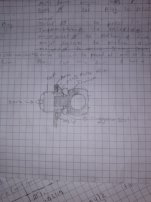JRRaftovich
Plastic
- Joined
- Jul 18, 2023
I trying to choose a steel to re-create an old car suspension part. The original (a trunnion cap) will not file, indicating that it is hard or hardened. When tested it showed Rc4, which should definitely file. Looking at spark test charts my best guess is that it is mild steel. The mating part, a trunnion (threaded pivot) Rockwell tested at 19Rc and is a case-hardened steel casting. Neither part showed wear. I need to match but not exceed that hardness so I don’t have to remake these anytime soon. The original also self-tapped with a weird broad profile thread into the stamped steel control arm. The originals stripped the arms in disassembly.
My best guess is that the original was medium carbon steel with flame/induction hardening thin enough that Rockwell tester didn't "see" it. We also don't have the shallow penetration set up as far as anyone at the shop knows.
I am remaking the part with a home-brew Class 5 interference thread (I need to match the -11 pitch of the trunnion at 1-1/8 OD to maintain 1/8” wall thickness) so that it doesn’t eat itself the next time I have to work on it. The handbook recommends Grade 5 (ballpark of QT 1045 correct?) for Class 5 (interference) external threaded parts.
My best choice by mechanical property and application was 1144 stress or fatigue -proof but they are harder than the trunnion untreated (25 and 30 Rc respectively). These cannot be heat treated further, as they are previously stress-relieved. Next best was 1045 and 4140/ 41L40. These are listed as 90 and 95 Rb respectively as supplied which seems too soft. They also are said to harden into the 50-60 Rc range. I have heard both require annealing to machine well, particularly the ChroMoly although the leaded stuff should be ok. I also hoped to avoid asking to use the heat treat oven as playing with old cars in not my real job. Then, again all they can say is no.
The part is roughly 1-1/8 long with a 1-1/8 hex and 1/8 walls at the internal and external threaded areas. Parts will be turned, bored, ext. threaded and int. threaded on a manual engine lathe with carbide tools.
The trunnion pivots inside the part on the threads, they are greased. The cap is the wear item as I cannot replace the original cast trunnion without even more difficulty.
What steel will harden to 19Rc by flame and have strength and toughness of xx40 steels? Could I anneal a harder steel without loosing strength or toughness? How much harder or softer than 19Rc could I get away with?
Thanks to anyone who finishes this book.
My best guess is that the original was medium carbon steel with flame/induction hardening thin enough that Rockwell tester didn't "see" it. We also don't have the shallow penetration set up as far as anyone at the shop knows.
I am remaking the part with a home-brew Class 5 interference thread (I need to match the -11 pitch of the trunnion at 1-1/8 OD to maintain 1/8” wall thickness) so that it doesn’t eat itself the next time I have to work on it. The handbook recommends Grade 5 (ballpark of QT 1045 correct?) for Class 5 (interference) external threaded parts.
My best choice by mechanical property and application was 1144 stress or fatigue -proof but they are harder than the trunnion untreated (25 and 30 Rc respectively). These cannot be heat treated further, as they are previously stress-relieved. Next best was 1045 and 4140/ 41L40. These are listed as 90 and 95 Rb respectively as supplied which seems too soft. They also are said to harden into the 50-60 Rc range. I have heard both require annealing to machine well, particularly the ChroMoly although the leaded stuff should be ok. I also hoped to avoid asking to use the heat treat oven as playing with old cars in not my real job. Then, again all they can say is no.
The part is roughly 1-1/8 long with a 1-1/8 hex and 1/8 walls at the internal and external threaded areas. Parts will be turned, bored, ext. threaded and int. threaded on a manual engine lathe with carbide tools.
The trunnion pivots inside the part on the threads, they are greased. The cap is the wear item as I cannot replace the original cast trunnion without even more difficulty.
What steel will harden to 19Rc by flame and have strength and toughness of xx40 steels? Could I anneal a harder steel without loosing strength or toughness? How much harder or softer than 19Rc could I get away with?
Thanks to anyone who finishes this book.


